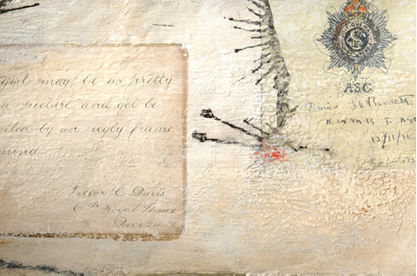


Maudís Book is a series of 30 individual artworks, each an excavation of a page from a family treasure - my paternal Great Grandmotherís First World War autograph book.
Maud Empson, my great grandmother, was born in Holt, Norfolk in 1895. At the outbreak of the Great War, Maud, aged 18, and her younger sister Dot, accompanied her father on his daily bread delivery to the training camp just outside the village. The camp was set up to prepare new recruits for active service in France. Maud carried with her a little book between 1914 and 1918 in which she collected poems and riddles, drawings and musings from the soldiers stationed there. It even includes some hand-written excerpts of musical compositions.
The autograph book is a quiet document recording the melancholy and reluctance felt by these young men before being sent to the Front Line.
Constructed from clay, mixed with paper pulp, Maudís Book reads as a series of clay pages, making visible records and tributes to the soldiers who signed the book. As clay tablets they reference the ancient clay writing tablets (cuneiform) from Mesopotamia, made three and a half thousand years ago, serving as recording devices carrying stories as hymns to the fragility of human culture.
Some of the pigments I used to colour the clay were dug from the Somme. Several of the works in this series also have fragments of barbed wire and shrapnel and even remains of personal charms and trinkets which I collected on the battlefields of Northern France (known by the farmers who work this land as ĎThe Metal Harvestí) which I stitched and embedded into their surfaces.
Maudís Book was exhibited at Phoenix Arts Centre, Exeter (2003) as part of the Text Festival ĎExcavation and the Wordí, and at the British Art Fair 2003 at the Royal College of Art, London (represented by Gordon Hepworth Fine Art).




 MAUDíS BOOK
MAUDíS BOOK

